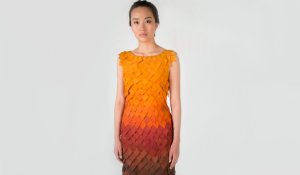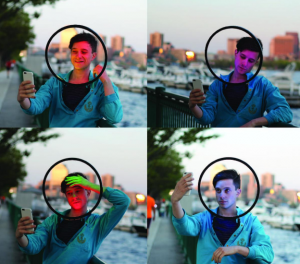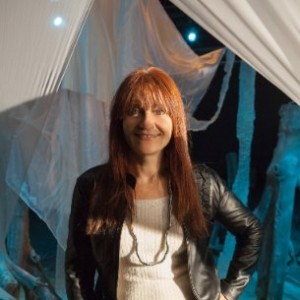Announcement and Call for Design Exhibition ISWC 2016
ISWC 2016, the 20th annual International Symposium on Wearable Computers, is the premier forum for wearable computing and issues related to on-body and worn mobile technologies. ISWC brings together researchers, product vendors, fashion designers, textile manufacturers, users, and related professionals to share information and advances in wearable technology.
ISWC invites submissions on everything related to computing on the body: on-body sensing and sensor networks; wearables for professional use, mobile healthcare, or entertainment; wearability and interaction; and “on-the-go” uses of mobile devices and systems.
Juried Exhibition
ISWC 2016’s Juried Design Exhibition invites submissions of original works of wearable technology and/or novel applications for new audiences using existing technologies. Submissions may comprise any type of wearable technology (electronic, mechanical, textile and garment-based, etc). Awards for the best design will be given in three categories: Aesthetic, Functional, and Fiber Art
- Submission deadline: June 12, 2016, 11:59pm PDT.
- Notification of acceptance: July 03, 2016.
- Camera-ready extended abstract due: July 17, 2016.
Categories
Functional:
Submissions to this category should be functionally-focused wearable designs, aimed at using technology to solve a particular problem or meet a specific need.
Aesthetic:
Submissions to this category should be aesthetically-focused wearable designs, aimed at developing an aesthetic or visual effect through the use of technology.
Fiber arts:
Submissions to this category should be non-wearable, but textile- or fiber-integrated innovations. Fiber arts submissions may be functionally or aesthetically focused. Confused about which category to pick? Many designs address both functional and aesthetic aspects of a problem. Designers should consider in which aspect their design is strongest, and submit it to that category.
Awards
Awards for the best design will be given in three categories: Aesthetic, and Functional and Fiber Art.
Awards from the 2015 Design Exhibition
The following awards were presented at the 2015 ISWC Design Exhibition. Congratulations to all of the winners!
Best in Show: Aesthetics
- Nan Zhao (MIT Media Lab)
- Joe Paradiso (MIT Media Lab)
Best in Show: Functional
Enhanced tradition: combining tech and traditional clothing
- Vilhelmina Sokol (Keio University)
- Kai Kunze (Keio University)
- Yuta Sugiura (Keio University)
- Masahiko Inami (Keio Media Design)
Best in Show: Fiber Arts
- Birce Ozkan (Parsons the New School for Design)

Submission
Designers are asked to submit an illustrated design statement detailing the work’s concept, motivation, intended audience and end-use, technological functionality, and execution. Detailed images must illustrate the text.
Please submit your document as one compiled PDF file, formatted according to the ACM extended abstracts format. The submission should not exceed 6 pages, including embedded images. All figures should be included in the document body and referenced in the text. Please cite all references used in the text according to the ACM formatting instructions. Your submitted PDF should not exceed 6 pages or 5MB. Please prepare your paper for blind review: do not include any names or institution affiliations within your submitted PDF.
Design submissions should include an illustration or image. It is strongly encouraged to include High Res Images and a Video at the time of submission. High Res Images and a Video will be required of all accepted designs for the camera ready submission and will be used in the ISWC Design Exhibition. Submit your design statement and supporting materials through the PrecisionConference site.
Please note: Accepted designs will need to for shipped/transported to Heidelberg, to arrive on or before September 12, 2016. Authors will be responsible for shipping items to and from Heidelberg, Germany.
Evaluation Criteria
1) Concept originality:
How novel is the concept or application? Has it been done before? Is the approach novel? The work should exhibit depth of understanding and insight.
2) Technological Innovation:
How innovative is the use of technology: have advances been made in the use of standard tools for a new purpose? Have new technologies been developed? What does the technology bring to the wearer or the viewer in the wearable environment?
3) Execution:
How professional and polished is the finished product? Have appropriate or novel construction techniques been implemented? How have standard hardware components been adapted for the wearable environment?
4) Communication and Rigor:
How well have the concept, novelty, and use of technology been communicated? Is the idea and process evident in written and visual materials?
5) Audience/Usability:
How appropriate is the design for the intended audience/purpose? (Aesthetic and Fiber Art.) How well have the designers addressed the usability of their interface/interaction? (Functional and Fiber Art.)
Jury Panel
Todd Harple
Todd is an Experience Engineer at Intel where he has worked since 2005. Todd has conducted global ethnographic and design research and presently he leads strategic innovation research and pathfinding activities within Intel’s New Devices Group. Prior to joining Intel, Todd worked in diverse settings including financial services and natural resource industries as well as in museums, community development and education. Todd earned a Master’s degree in Historical Administration and Museum studies from the University of Kansas in 1995 and a PhD in Cultural Anthropology from The Australian National University in 2001.
Galina Mihaleva
Galina Mihaleva is an Assistant Professor at ADM; Nanyang Technological University in Singapore She holds graduate degrees in Textile and Fashion Design and a Ph.D. from the Academy of Fine Art in Sofia.
Her interest in fashion lies in exploring the extent to which we experience fashion (emotional, intellectual and sensual aspects) and how we might be able to accomplish a higher state of connectivity between the body and our clothing.
Her interdisciplinary work has been shown in galleries and museums across United States, Asia, Central and South America and Europe. She was nominated for the design award at the Cooper Hewitt Museum in New York in 2009. Beyond in-depth analysis of cultural values she combines traditional tailoring methods while developing and using new materials and innovative construction proses. Unbounded by the old rules, Galina now offers her work as a testimony to the power of beauty and expression, and to the transcendent human spirit. She regards her works as being timeless.
URL: http://galina.foliohd.com/all
Evaluation
All submissions will be evaluated by the jury panel for their following design elements, as outlined above: concept, use of technology, execution, and visual/written communication. Aesthetically-focused designs will also be evaluated with respect to their aesthetic novelty and appropriateness for the intended purpose, and functionally-focused designs will also be evaluated with respect to the usability of the technology for the specified audience.
Accepted works will be exhibited at the conference venue, and accepted exhibitors may be asked to supply additional visual materials to accompany the exhibition. Designers will assume the cost of transporting their work to and from Heidelberg, to arrive before September 12th, 2016.
Design statements from all accepted designs will be included in the ISWC Adjunct Proceedings. Design awards will be presented at the conference for the Aesthetic, Functional, and Fiber Arts categories.
- Submission deadline: June 12, 2016, 11:59pm PDT.
- Notification of acceptance: July 03, 2016.
- Camera-ready extended abstract due: July 17, 2016.
Contact
For questions regarding the ISWC 2016 Design Exhibition, please mail the Design Chair, James Hallam, at design@iswc.net.




